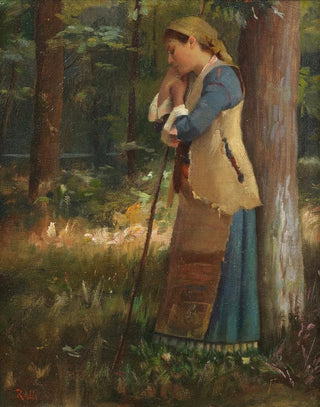Art print | Bergère au repos - Theodoros Ralli


View from behind

Frame (optional)
Theodoros Ralli – Captivating Introduction
In the vast panorama of art history, some works manage to capture the essence of an era while offering an intimate glimpse into the human condition. "Art print Bergère au repos - Theodoros Ralli" is one of these remarkable pieces. Painted at the end of the 19th century, this work embodies the fusion of realism and impressionism, bearing witness to an artistic sensitivity that transcends cultural boundaries. Through the portrait of a young shepherdess, Ralli invites us to contemplate a moment of serenity, a suspended instant in time where nature and humanity meet with delicate grace.
Style and uniqueness of the work
The style of "Bergère au repos" is distinguished by its subtle use of light and color. Ralli, a true master of light, manages to create a soothing atmosphere through gentle nuances and delicate shadows. The composition of the work is carefully crafted, highlighting the central figure of the shepherdess, whose face expresses both sweetness and melancholy. The background, with its bucolic landscapes, reinforces the feeling of escape experienced when contemplating this piece. The meticulously painted details, such as the traditional clothing of the shepherdess and the texture of natural elements, demonstrate a deep respect for reality while revealing a certain idealization of rural life. This stylistic approach gives the work a poetic dimension, inviting the viewer to immerse themselves in a world where simplicity and beauty coexist harmoniously.
The artist and his influence
Theodoros Ralli, born in Greece and active in France, is an artist whose career reflects cultural exchanges between the Orient and the West. His training at the Athens School of Fine Arts, followed by a stay in Paris, allowed him to incorporate diverse influences, ranging from Neoclassicism to Impressionism. Ralli is particularly recognized for his depictions of peasant life, which he approaches with a unique sensitivity. His work highlights the beauty of everyday scenes, while exploring universal themes such as

Matte finish

View from behind

Frame (optional)
Theodoros Ralli – Captivating Introduction
In the vast panorama of art history, some works manage to capture the essence of an era while offering an intimate glimpse into the human condition. "Art print Bergère au repos - Theodoros Ralli" is one of these remarkable pieces. Painted at the end of the 19th century, this work embodies the fusion of realism and impressionism, bearing witness to an artistic sensitivity that transcends cultural boundaries. Through the portrait of a young shepherdess, Ralli invites us to contemplate a moment of serenity, a suspended instant in time where nature and humanity meet with delicate grace.
Style and uniqueness of the work
The style of "Bergère au repos" is distinguished by its subtle use of light and color. Ralli, a true master of light, manages to create a soothing atmosphere through gentle nuances and delicate shadows. The composition of the work is carefully crafted, highlighting the central figure of the shepherdess, whose face expresses both sweetness and melancholy. The background, with its bucolic landscapes, reinforces the feeling of escape experienced when contemplating this piece. The meticulously painted details, such as the traditional clothing of the shepherdess and the texture of natural elements, demonstrate a deep respect for reality while revealing a certain idealization of rural life. This stylistic approach gives the work a poetic dimension, inviting the viewer to immerse themselves in a world where simplicity and beauty coexist harmoniously.
The artist and his influence
Theodoros Ralli, born in Greece and active in France, is an artist whose career reflects cultural exchanges between the Orient and the West. His training at the Athens School of Fine Arts, followed by a stay in Paris, allowed him to incorporate diverse influences, ranging from Neoclassicism to Impressionism. Ralli is particularly recognized for his depictions of peasant life, which he approaches with a unique sensitivity. His work highlights the beauty of everyday scenes, while exploring universal themes such as






